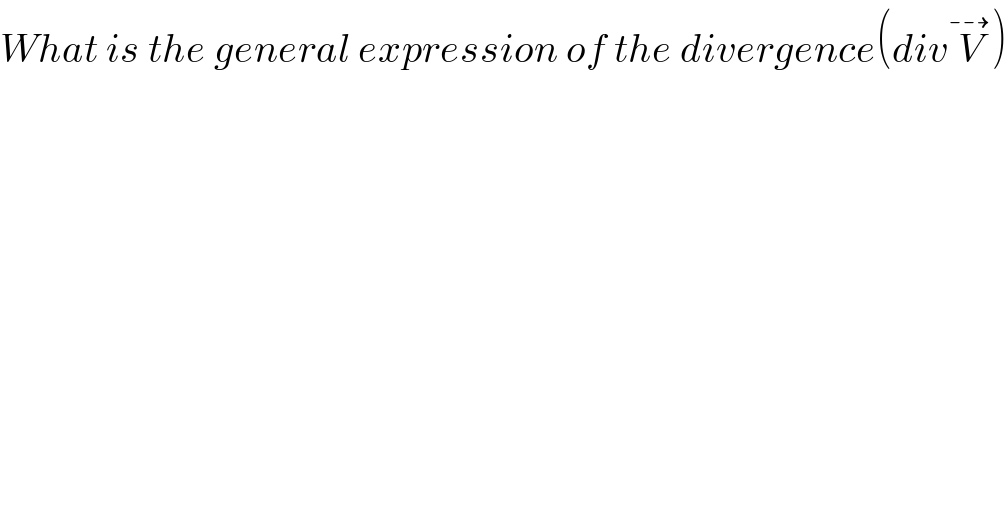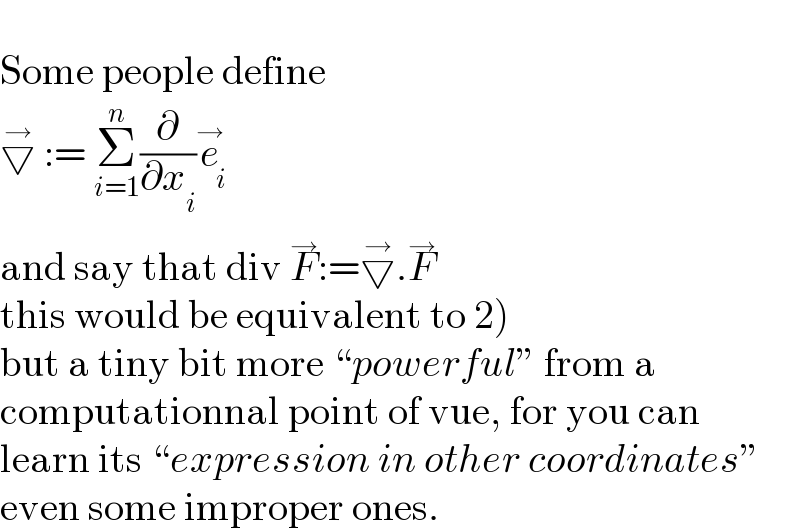
Question and Answers Forum
Question Number 157199 by Fresnel last updated on 20/Oct/21

Answered by TheHoneyCat last updated on 21/Oct/21
![It depends on your level: 1) If (to you) V^→ is a tridimentionnal vector V^→ =V_x e_x ^→ +V_y e_y ^→ +V_z e_z ^→ then: div V^→ =(∂V_x /∂x)+(∂V_y /∂y)+(∂V_z /∂z) 2) V^→ is a function from R^n to R^n with: denoting V_i its coordinate−functions (ie the function V_i from R^n to R such that ∀i∈[∣1,n∣] V^→ .e_i ^→ =V_i ) Then: div V^→ =Σ_(i=1) ^n (∂V_i /∂x_i ) 3) If V^→ is a differentiable map of R^n →R^n (or any set isomorphic to it) its divergence is defined as above it might not look like there is a difference from 2) but the fact that it is differentable assures that the divergence does not depend on the choice of coordinates, hence it is a general operator on the set of differentible functions, and no longer a formula that refers to “actual” coordinates](Q157279.png)
Commented by TheHoneyCat last updated on 21/Oct/21

| ||
Question and Answers Forum | ||
Question Number 157199 by Fresnel last updated on 20/Oct/21 | ||
 | ||
Answered by TheHoneyCat last updated on 21/Oct/21 | ||
![It depends on your level: 1) If (to you) V^→ is a tridimentionnal vector V^→ =V_x e_x ^→ +V_y e_y ^→ +V_z e_z ^→ then: div V^→ =(∂V_x /∂x)+(∂V_y /∂y)+(∂V_z /∂z) 2) V^→ is a function from R^n to R^n with: denoting V_i its coordinate−functions (ie the function V_i from R^n to R such that ∀i∈[∣1,n∣] V^→ .e_i ^→ =V_i ) Then: div V^→ =Σ_(i=1) ^n (∂V_i /∂x_i ) 3) If V^→ is a differentiable map of R^n →R^n (or any set isomorphic to it) its divergence is defined as above it might not look like there is a difference from 2) but the fact that it is differentable assures that the divergence does not depend on the choice of coordinates, hence it is a general operator on the set of differentible functions, and no longer a formula that refers to “actual” coordinates](Q157279.png) | ||
| ||
Commented by TheHoneyCat last updated on 21/Oct/21 | ||
 | ||